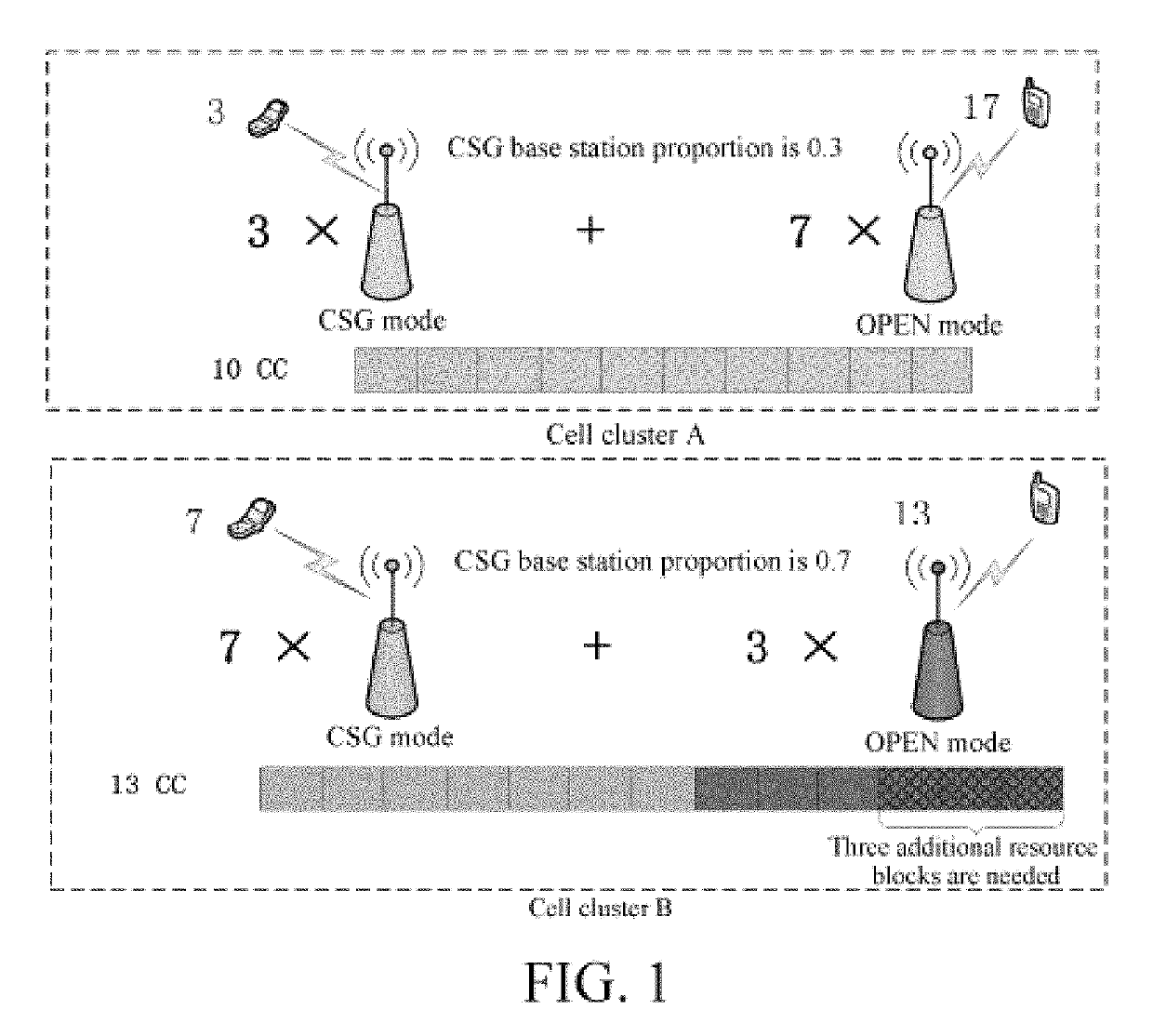Inter-network shared frequency spectrum optimization system and method
a technology of internet shared spectrum and optimization system, which is applied in the direction of data switching network, digital transmission, network topologies, etc., can solve the problems of serious waste of spectrum resources, limited spectrum resources suitable for wireless transmission, and crowded spectrum resources at this band, so as to improve the average qos of each operator base station, improve the efficiency of the spectrum and improve the qos of the base station
- Summary
- Abstract
- Description
- Claims
- Application Information
AI Technical Summary
Benefits of technology
Problems solved by technology
Method used
Image
Examples
first embodiment
[0112]In the first embodiment, in the shared spectrum pool initialization stage, the first network and the second network divide the spectrum resources of the shared spectrum pool according to the CSG-mode base station proportion of each cell cluster and the quantity of the member base stations. The CSG-mode base station proportion is adopted due to the consideration of a relative small number of service subscribers of CSG base stations, spectrum resources of which the quantity is lower than an average value can be allocated thereto in an initialization process, and remaining spectrum resources in the shared spectrum pool are allocated to base stations working in an OPEN mode, thereby guaranteeing the QoS. If an OPEN base station proportion is adopted for calculation, the same performance will be provided.
[0113]Spectrum resources BandA occupied by the cell cluster A in the shared spectrum pool shall be adjusted, accordingly, to:
[0114]BandA=TA×(1-AOPEN)×BandCSG+TA×AOPEN×Band-BandCSG×...
third embodiment
[0120]In the third embodiment, the first network and the second network divide the spectrum resources of the shared spectrum pool according to the quantity of CSG base stations and the quantity of member base stations. Spectrum resources BandA occupied by the cell cluster A in the shared spectrum pool shall be adjusted, accordingly, to:
[0121]BandA=NACSG×BandCSG+(TA-NACSG)×Band-BandCSG×(NACSG+NBCSG)TA-NACSG+TB-NBCSG(6)
[0122]Spectrum resources BandB occupied by the cell cluster B in the shared spectrum pool shall be adjusted to:
[0123]BandB=NBCSG×BandCSG+(TB-NBCSG)×Band-BandCSG×(NACSG+NBCSG)TA-NACSG+TB-NBCSG(7)
[0124]where the quantity of member base stations of the cell cluster A is TA, the quantity of CSG base stations thereof is NACSG, the quantity of member base stations of the cell cluster B is TB, the quantity of CSG base stations thereof is NBCSG, the size of the shared spectrum pool is Band (MHz), and a working bandwidth of each CSG base station is BandCSG (MHz).
[0125]
[0126]In o...
fourth embodiment
[0127]In the fourth embodiment, the first network and the second network divide the spectrum resources of the shared spectrum pool according to the quantity of OPEN base stations and the total quantity of member base stations of the first network and the second network.
[0128]Spectrum resources BandA occupied by the cell cluster A in the shared spectrum pool shall be adjusted, accordingly, to:
[0129]BandA=(TA-MAOPEN)×BandCSG+MAOPEN×Band-BandCSG×(TA-MAOPEN+TB-MBOPEN)MAOPEN+MBOPEN(8)
[0130]Spectrum resources BandB occupied by the cell cluster B in the shared spectrum pool shall be adjusted to:
[0131]BandB=(TB-MBOPEN)×BandCSG+MBOPEN×Band-BandCSG×(TA-MAOPEN+TB-MBOPEN)MAOPEN+MBOPEN(9)
[0132]where the quantity of member base stations of the cell cluster A is TA, the quantity of OPEN-mode base stations thereof is MAOPEN, the quantity of member base stations of the cell cluster B is TB, the quantity of OPEN-mode base stations thereof is MBOPEN, the size of the shared spectrum pool is Band (MHz),...
PUM
 Login to View More
Login to View More Abstract
Description
Claims
Application Information
 Login to View More
Login to View More - R&D
- Intellectual Property
- Life Sciences
- Materials
- Tech Scout
- Unparalleled Data Quality
- Higher Quality Content
- 60% Fewer Hallucinations
Browse by: Latest US Patents, China's latest patents, Technical Efficacy Thesaurus, Application Domain, Technology Topic, Popular Technical Reports.
© 2025 PatSnap. All rights reserved.Legal|Privacy policy|Modern Slavery Act Transparency Statement|Sitemap|About US| Contact US: help@patsnap.com



